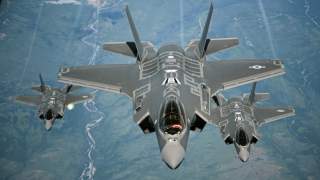America's 5 Greatest Military Victories (and 5 Most Shocking Defeats)
Let the debate begin.
It left the underbelly of the Confederacy open to attack by Union armies, and gave thousands of slave the opportunity to make their way to Union lines. Lee recovered from his defeat at Gettysburg, and the armies of the Confederacy remained viable for two more years, especially in the east. Vicksburg, however, fatally undercut the national unity of the Confederacy, and its ability to manage its own territory.
Battle of Midway:
In the first six months of 1942, the Imperial Japanese Navy (IJN) had accomplished nearly every strategic task that it had set for itself. The IJN had facilitated the seizure the Dutch East Indies, Indochina, Malaya and Singapore; it had destroyed the major units of the Royal Navy in the Far East, and ranged deep into the Indian Ocean; and it had devastated Dutch, Australian, American and British naval strength at engagements from Pearl Harbor to Java Sea.
The most important remaining task was the destruction of the carriers of the U.S. Navy’s Pacific Fleet. The Pearl Harbor attack had damaged or destroyed most of the battleship force, but the three carriers of the Pacific Fleet were on other missions. These carriers would soon be supported by three more, although USS Lexington was lost at the Battle of Coral Sea, which also damaged USS Yorktown and HIJMS Shokaku.
Imperial Japanese Navy Admiral Isoroku Yamamoto decided to attempt to draw out the USN by invading Midway, a small island roughly equidistant between Japan and the United States. If taken, Midway could provide a submarine base capable of supporting attacks on U.S. shipping. The main objective, however, was the destruction of the U.S. fleet.
Apprised of Japanese movements because of code breaking, Nimitz decided to commit his remaining carriers, including the battered USS Yorktown, despite the expected Japanese superiority. Nimitz had two advantages. First, U.S. intelligence had a much better command of Japanese dispositions than vice versa. The IJN expected the American carriers to come out and play, but didn’t have a sense of when and where they would attack. Second, the vast fleet of carriers, cruisers and battleships rolling off American production lines gave Nimitz the luxury to engage in risk acceptant behaviors.
The battle resulted in a devastating American victory. Japan lost four fleet carriers to American dive-bombers, and the Combined Fleet withdrew from Midway without attempting an invasion. The USN lost only one carrier (USS Yorktown). Japan continued its offensive in other areas, but the presumptive superiority of the IJN was broken. Japan and the United States would shortly thereafter descend into the bitter slog of Guadalcanal, a campaign of attrition that unavoidably favored the greater resources of the United States.
Midway may not have won the war; Japan continued to fight for three more years, and was probably at the limit of its offensive sphere in any case. Still, it represented a key inflection point of the Pacific War, squaring the score and giving the initiative to the United States.
Operation Overlord:
On June 6, 1944, the United States and the United Kingdom led a coalition of Allied countries in the invasion of German-controlled France. The operation, painstakingly planned for months (and prepared for even longer) brought U.S. forces into direct conflict with the Wehrmacht in decisive terms, allowing its defeat in the West and facilitating the collapse of Nazi Germany.
Overlord was not a solely American operation, by any standards. The United Kingdom was an equal partner, and both Canada and Poland made big contributions. Nevertheless, it represented a culmination of the industrial, logistical and intellectual contributions of the United States to the Western alliance, and was made possible by the unique combination of American industrial and military might.
Preparations for Overlord began in mid-1943. Over the next year, the United States and Great Britain would accumulate a massive ground force in southern England, supported by a huge tactical air force and a flotilla of warships and landing craft. When the Allies struck across a broad front in Normandy, German defenders caused significant casualties, but failed to turn back the attack.
Although the Germans managed to keep the Allies hemmed in for about a month, American forces broke out in late July. With forces able to maneuver in France, the Germans had no hope of putting up an effective defense. In December 1944, the Wehrmacht launched a surprise, last-ditch offensive against Allied forces in the Ardennes forest. The offensive was intended to drive to the sea, splitting Allied forces in two and forcing the Western Allies to come to terms with Nazi Germany. Successful American resistance at Bastogne halted the German advance, ending the last opportunity for Germany to affect the course of the war.
Conclusion:
America is quintessentially modern, and success in modern warfare depends on much more than deeds of heroic valor. Those deeds are undeniably part of victory, but they require context; the ability to aggregate the tools of national power behind a singular purpose.
Since the Revolutionary War, the greatest American military successes have depended on careful, long-range planning, the organization of assets and the commitment to overwhelming the enemy. The American genius for war, to the extent that it exists, lies in the ability to build advantage so that genius, heroism and chance on the battlefield don’t need to play decisive roles. The tactical battlefield is nothing like a chessboard, but the operational and strategic fields sure are, and American commanders have proven to be exceedingly adept players.
Image: Creative Commons/Flickr.

